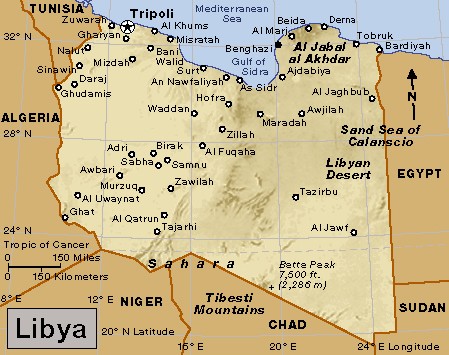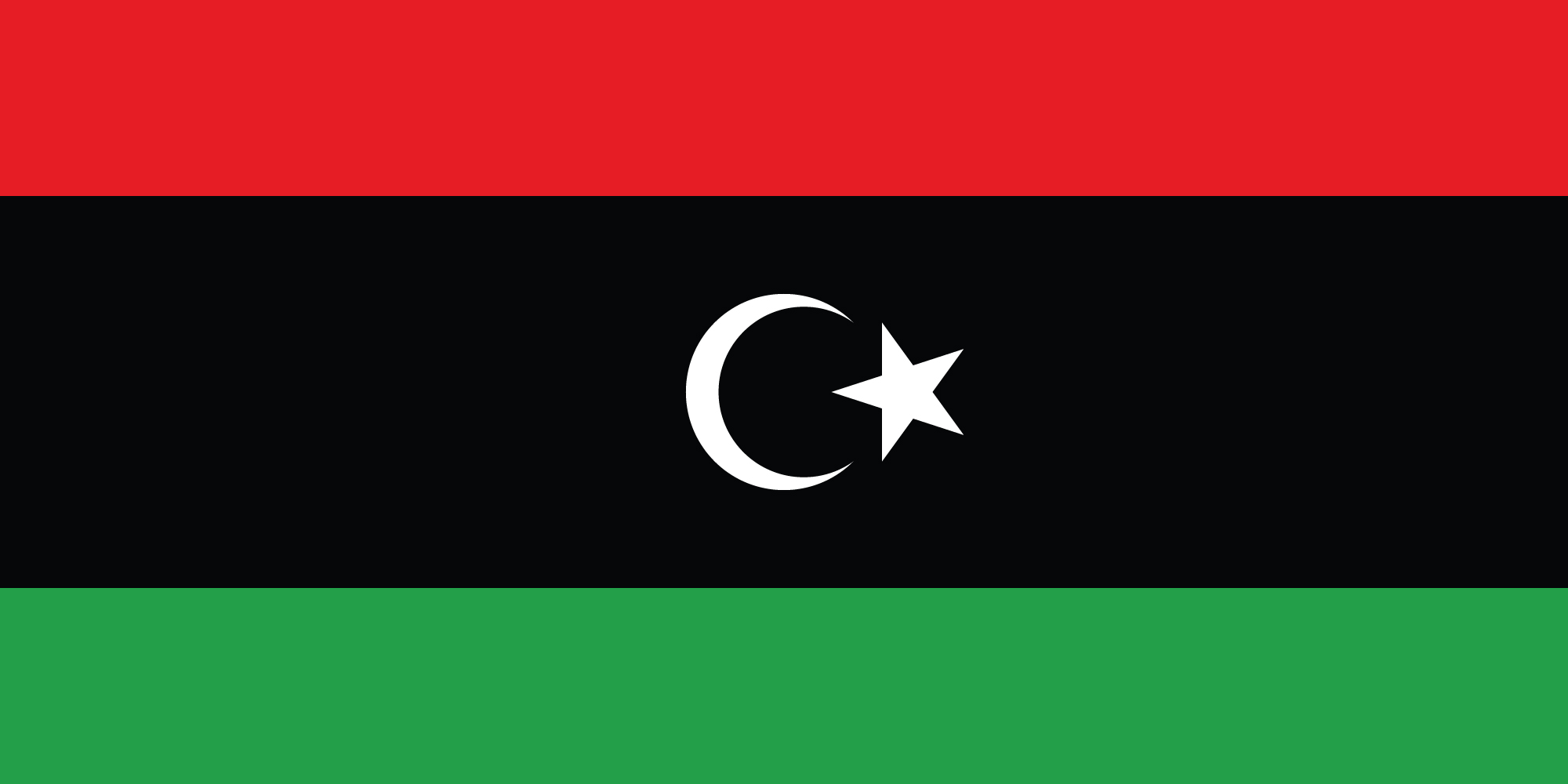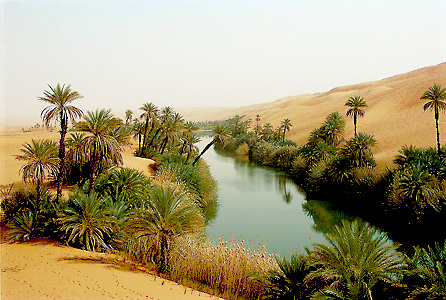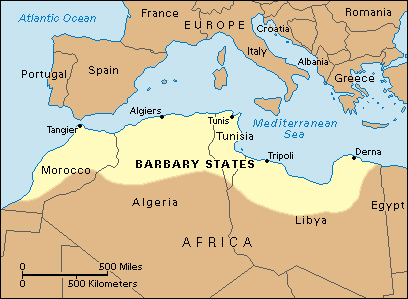Libya is an Arab country in northern Africa. It lies on the coast of the Mediterranean Sea. The country is bordered by Egypt and Sudan on the east, Chad and Niger on the south, and Algeria and Tunisia on the west. Tripoli is Libya’s capital and largest city.

The vast, dry Sahara covers most of Libya, and the country has few natural resources. But the discovery of petroleum in 1959 injected huge sums of money into Libya’s economy. The government of Libya used some of this wealth to improve farmland and provide services for the people.
Almost all of Libya’s people are of mixed Arab and Berber ancestry and are Muslims. Until the early 1900’s, Libya consisted of three separate geographical and historical regions. It became a united, independent country in 1951.
Government
In 2011, a rebellion overthrew Mu’ammar Muhammad al-Qadhafi, Libya’s head of state since 1969. Most of the international community recognized the National Transitional Council (NTC), the political arm of the rebellion, as Libya’s transitional government. In August 2012, the NTC handed power to the country’s newly elected National Congress. In 2014, warring factions depleted the power of the National Congress, and much of the country fell into chaos. A United Nations-backed Government of National Accord (GNA) took power in Tripoli in 2016. A rival faction in Tobruk, however, refused to acknowledge the legitimacy of the GNA.

People
Population and ancestry.
Most of Libya’s people live along the Mediterranean coast or in the upland regions just south of the coast. More than 90 percent of Libya’s population is of mixed Arab and Berber ancestry. The Berbers lived in Libya before the Arabs arrived in the A.D. 600’s.
Languages.
Arabic, the official language, is spoken by almost all Libyans. Many educated Libyans speak a second language, particularly English or Italian.
Way of life.
Most of Libya’s people live in urban areas. The country’s rural dwellers live mostly in villages or desert oases. Some nomads move with their sheep, goats, and camels in search of pasture.
The expansion of the Libyan economy after the mid-1900’s triggered a substantial migration from rural areas to the cities. The transition from rural to urban life required many difficult adjustments. For example, rural Libyans live as an extended family, with several generations sharing a single home. But this arrangement is not practical in Libya’s crowded cities.
The status of women in Libya changed dramatically in the late 1900’s. Women once received little or no education and were largely confined to the home. As a result of the changes, women have the legal right to participate fully in Libyan society. But many traditional attitudes about women remain. Libyan women form only about 10 percent of the work force, but this percentage is increasing as more women become educated.
Housing.
Libya’s large cities look much like those in North America and Western Europe. High-rise office and apartment buildings fill the downtown areas. Suburban areas have more spacious single-family dwellings. In rural areas, most people live in stone or mud-brick houses. Often, families have a single room for all activities and a nearby shelter for their animals. The flood of people from the country to the cities has created overcrowding, particularly in older urban neighborhoods.
Clothing.
Traditional garments are commonly worn in rural areas of Libya. Men wear a loose cotton shirt and trousers covered by an outer cloak. They often wear a flat, brimless, tight-fitting cap. Women traditionally wear a full-length robe. Some people in Libya’s cities wear these garments to indicate their regard for traditional values and practices. But most city dwellers wear clothing similar to that worn by North Americans and Europeans.
Religion.
Islam is Libya’s official religion. Almost all Libyans are Muslims and belong to the Sunni branch of Islam. The 1977 Constitution ordered that all legislation must agree with Islamic law.
Education.
When Libya became independent in 1951, only about 20 percent of the population could read and write. But oil revenues provided the country with money to attack widespread illiteracy. Today, most of Libya’s adults can read and write.
All Libyan children from 6 to 15 years of age are required to attend school. The free state education system provides six years of primary school and three years each of preparatory school and high school. Libya has several universities. The largest is the University of Tripoli.
Land and climate
The huge Sahara, the desert that extends across northern Africa, covers about 95 percent of Libya. Except for scattered desert oases, only the land near the Mediterranean Sea in northern Libya is inhabitable and useful for agriculture.

Huge sand dunes make up most of the inland desert region of Libya. A part of the Sahara called the Libyan Desert covers the eastern part of the country’s inland area. The desert terrain rises gradually from north to south, forming rugged mountains along the southern border. Libya’s highest point, Bette Peak, rises 7,500 feet (2,286 meters) above sea level in the southeast.
The desert climate is characterized by extreme high and low temperatures. Daytime temperatures reach an average high of 100 °F (38 °C). But nights are cool, averaging 50 °F (10 °C). Rainfall in the desert averages less than 2 inches (5 centimeters) each year.
Most Libyans live near the Mediterranean coast. In the west, some live on a fertile plain almost 200 miles (320 kilometers) long. Others live on the coast between Benghāzī and Derna (also spelled Darnah). The Green Mountain region east of Benghāzī also has many villages. In the center of the country, the Sahara reaches northward to the Gulf of Sidra. It forms a desolate barrier between the densely populated eastern and western stretches of coastline.
The Mediterranean Sea strongly influences the climate of the coastal region. The area has warm summers and mild winters. In January, temperatures in Tripoli average 52 °F (11 °C). July temperatures in Tripoli average 81 °F (27 °C). The coast receives more rain than the inland desert—about 16 inches (41 centimeters) annually.
Economy
Libya has a developing economy that depends heavily on petroleum. But the oil industry employs only a small percentage of the country’s workers. Most Libyan workers are employed by service industries. The country has a high unemployment rate. Despite the large amount of money that Libya receives from oil, many Libyans live in poverty.
Mining.
Petroleum accounts for much of Libya’s total economic production, and for most of the country’s export earnings. Libya has the largest oil reserves in Africa. Much of Libya’s oil is in the north-central part of the country. The national government controls petroleum mining. Since the early 2000’s, natural gas production has grown significantly. Libya also mines gypsum, iron ore, lime, salt, and sulfur.
Service industries
are economic activities that produce services rather than goods. Such industries make up much of the value of the total economic production in Libya. They employ well over half of all Libyan workers. Government services make up the most important service industry. Hotels, restaurants, and shops benefit from tourists who visit from Egypt, Tunisia, and other countries.
Manufacturing
plays a small role in Libya’s economy. The most important manufactured goods are refined petroleum products and petrochemicals. Other products include cement, processed foods, steel, and textiles. Libya’s northern cities are the chief manufacturing centers.
Agriculture
accounts for a small percentage of the total value of economic production in Libya. Only a small amount of the land is useful for agriculture. Libya must import most of the food it needs. The country’s chief crops include almonds, barley, dates, olives, potatoes, tomatoes, and wheat. Farmers and herders also raise such livestock as chickens, dairy cattle, goats, and sheep.
Families own most of the farmland in Libya. Mechanized farm machinery is used on large farms, but traditional tools are often used on small family farms.
Trade.
The export of oil and petroleum products accounts for most of the total value of Libyan exports. Electrical equipment, food, machinery, and transportation equipment are major imports. The value of Libya’s exports is higher than that of its imports. Libya’s leading trade partners include China, France, Italy, Spain, Turkey, and the United Arab Emirates.
Transportation and communication.
Libya’s national airline, Libyan Airlines, connects Libya with other countries. Benghāzī and Tripoli have international airports. The chief seaports are Benghāzī, Port Brega, and Tripoli. Paved roads link the major cities of northern Libya and connect them with the desert oases.
Before the 2011 rebellion that overthrew Qadhafi, the government controlled newspapers and radio and television broadcasting. In 2011, many new newspapers began to be published.
History
Early days.
Berbers are believed to be the earliest inhabitants of Libya. In the 600’s B.C., Greek colonists settled in the northeastern part of the region. Their province became known as Cyrenaica. In the 400’s B.C., the ancient city of Carthage, in what is now Tunisia, established trading centers in the northwestern part of the region. This province became known as Tripolitania.

The Romans destroyed Carthage in 146 B.C., and Tripolitania eventually became part of Rome’s empire. A Germanic tribe called the Vandals captured the region in A.D. 431. In the 500’s, Byzantine forces conquered the region. Rebellions by Berber tribes created instability that aided Arab entry into the region.
Arab soldiers, spreading their new religion of Islam, entered Cyrenaica in 642 and occupied Tripoli in 643. A succession of Arab and Berber dynasties then controlled what is now Libya. The culture of northwestern Libya developed along with the political units just west of it, while development in the east was strongly influenced by neighboring Egypt.
In 1551, the Ottomans captured Tripoli. They incorporated Tripolitania, Cyrenaica, and the southwestern region known as the Fezzan into their empire, which was centered in Asia Minor (now part of Turkey). But local rulers had almost complete freedom. From the 1500’s to the early 1800’s, private ships commanded by Barbary corsairs (sea raiders) preyed on European and U.S. shipping in the Mediterranean. The United States fought a war against the corsairs in the early 1800’s. 
Italian control.
Italy invaded the coastal regions in 1911 and took control of the three provinces in 1912. During the 1920’s and 1930’s, the Italians sponsored many improvement projects, such as towns, roads, and irrigation systems, luring thousands of European immigrants to the country. But in Cyrenaica, the Sanusi brotherhood, a Muslim religious and social reform group, organized stiff opposition to Italian rule. During World War II, members of the Sanusi brotherhood cooperated with the British in Egypt against Italy, their common enemy. In 1942, the United Kingdom established a military administration in the north. French forces took control of the Fezzan.
Independence.
In December 1951, the United Nations (UN) called for the independence of all of Libya. A federal state came into being, with Muhammad Idris al Mahdi as-Sanusi, leader of the Sanusi resistance, as king. The three provinces—Cyrenaica, Tripolitania, and the Fezzan—had considerable authority to rule themselves. But their separate geographical and cultural development fostered an atmosphere of localism and rivalry that complicated the nation-building process. The provinces were abolished in 1963, and Libya became a united kingdom controlled largely by the central government.
The discovery of oil in Libya in 1959 transformed the country from a poverty-stricken nation into one of the wealthiest in the world. But widespread discontent resulted, because the ruling class controlled the wealth.
In September 1969, a group of officers known as the Revolutionary Command Council (RCC) overthrew King Idris and seized power. Colonel Mu’ammar Muhammad al-Qadhafi, who led the revolution, became the head of Libya’s government. Under his rule, the government took control of most economic activities. Qadhafi tried to forge unions with a number of Arab states. But none of these efforts succeeded for more than a brief period. 
During the 1970’s, oil revenues were used to fund ambitious social and economic development projects. Existing political institutions were replaced by popular assemblies. Despite the appearance of democracy, Qadhafi’s government tolerated no political opposition.
Libya supported a number of political movements throughout the world, particularly the Palestine Liberation Organization (PLO) and the Polisario Front, in Western Sahara. It backed a rebellion in Chad. Libya also supported Iran’s declaration of an Islamic republic in 1979.
Strained relations with the United States.
The leaders of many nations denounced Qadhafi for interfering in the affairs of other countries. During the 1980’s, bitter antagonism surfaced between Libya and the United States. The United States accused Qadhafi of aiding terrorists. Libya, in turn, charged that the United States was attempting to overthrow its government.
In January 1986, U.S. President Ronald Reagan broke all economic ties with Libya. That March, Libya fired missiles on U.S. military aircraft over the Gulf of Sidra. In April, Reagan ordered U.S. planes to bomb military installations at Tripoli and Benghāzī. Reagan claimed to have evidence that linked Libya to the bombing of a West Berlin nightclub, in which an American serviceman was killed and many were injured. Conflict again erupted in early 1989, when two American aircraft downed two Libyan jets over the Mediterranean. The American airmen claimed that the Libyan planes were armed and aggressively heading toward them.
During the 1980’s, increased production and decreased consumption of petroleum throughout the world caused Libya’s oil revenues to decline. Nevertheless, the government moved forward with certain development projects, including a pipeline for carrying water from underground springs in the Sahara to the more densely populated coastal regions.
United Nations sanctions.
In 1992 and 1993, the United Nations imposed sanctions on Libya for refusing to turn over Libyans suspected of two terrorist attacks. The Libyans were accused of placing bombs aboard an American civilian airliner that exploded over Lockerbie, Scotland, in 1988 and a French civilian airliner that blew up over West Africa in 1989. The two explosions killed 441 people. Sanctions included the cancellation of international air service to Libya, the suspension of military sales, and the reduction of Libya’s diplomatic corps abroad.
In 1999, Libya turned over to UN officials two men suspected of planting the bomb on the American airliner. The United Nations suspended its sanctions on Libya after the men were in custody. In 2001, a special Scottish court set up in the Netherlands convicted one of the suspects, Abdel Basset Ali al-Megrahi, of murder and sentenced him to life imprisonment. It acquitted the other suspect, Lamen Khalifa Fhimah. In 2003, Libya accepted formal responsibility for the bombing of the American airliner and agreed to pay compensation to the families of the victims. Shortly afterward, the UN fully lifted its sanctions against Libya.
At the end of 2003, Libya’s relations with Western countries improved further after it announced that it was abandoning plans to develop weapons of mass destruction—that is, biological, chemical, or nuclear weapons. In 2004, Libya agreed to compensate the families of the victims of the French airliner bombing. Later that year, the United States ended most of the economic sanctions it had imposed on Libya in the 1980’s. In 2006, the United States removed Libya from its list of terrorism sponsors and later restored diplomatic relations with the country.
Recent developments.
In 2011, violent protests led to an open, armed rebellion against Qadhafi’s government. The Libyan military responded by attacking rebel strongholds, killing thousands. The United Nations passed a resolution calling for “all necessary measures” to protect Libyan civilians. Air strikes led by United States, French, and British warplanes then hit Libyan government positions. As fighting continued, the North Atlantic Treaty Organization (NATO) took over the military operations aimed at protecting civilians. In June, the International Criminal Court (ICC) issued an arrest warrant for Qadhafi for crimes against humanity. The UN created the ICC to try individuals for crimes of concern to the international community. By August, rebel forces controlled most of the country, including Tripoli. Qadhafi fled the capital and went into hiding. On October 20, Qadhafi was killed in his hometown of Surt (also spelled Sirte).
In July 2012, Libyans voted heavily in favor of the centrist National Forces Alliance (NFA) party in their country’s first elections since 1964. In September 2012, terrorists attacked the U.S. consulate in Benghāzī, killing the U.S. ambassador and three other Americans. 
Radical militias still active after the 2011 rebellion remained in control of parts of Libya in 2013. Sporadic fighting between the militias and government troops erupted in Benghāzī and other cities. In October, an armed group briefly kidnapped Libyan Prime Minister Ali Zeidan, but the group released him unharmed.
In 2014, with much of Libya still under militia control, Zeidan was forced from power. Minister of Defense Abdullah al-Thinni became prime minister but quickly announced his resignation. Al-Thinni was to remain in office until the National Congress found a replacement. Fighting between rival rebel factions intensified, and an Islamist militia took control of Tripoli. Members of the government fled to the northeastern city of Tobruk, where they allied themselves with anti-Islamist rebels led by former Libyan Army General Khalifa Haftar.
Islamic State terrorists massacred 21 Egyptian Christians in eastern Libya in 2015. It was the first known action in Libya by the Islamic State, also known as the Islamic State in Iraq and Syria (ISIS). In response to the killings, Egyptian warplanes bombed suspected Islamic State camps and training sites in Libya. Islamic State fighters then wedged themselves between the nation’s warring factions and took areas of eastern and central Libya.
In 2016, a United Nations-backed Government of National Accord (GNA) led by Fayez al-Sarraj took power in Tripoli. The rival faction in Tobruk, however, refused to acknowledge the GNA. Since then, violence between the factions, as well as terrorist activity, has killed many Libyans and largely destroyed the nation’s economy and infrastructure. Many people have fled Libya, and hundreds of thousands of others are displaced within the country.
The UN continued attempts to reconcile the rival factions and stabilize the nation in 2020. In August, the GNA declared a ceasefire. In October, the rivals signed a permanent ceasefire agreement. In February 2021, Mohammad Younes Menfi was elected to head a three-member presidential council for the interim government.
In September 2023, a powerful cyclone called Storm Daniel struck Libya’s Mediterranean coast. In Derna (also spelled Darnah), heavy rains from the storm caused two dams to burst, resulting in catastrophic flooding and destruction. Over 4,000 people were killed, and tens of thousands lost their homes.
